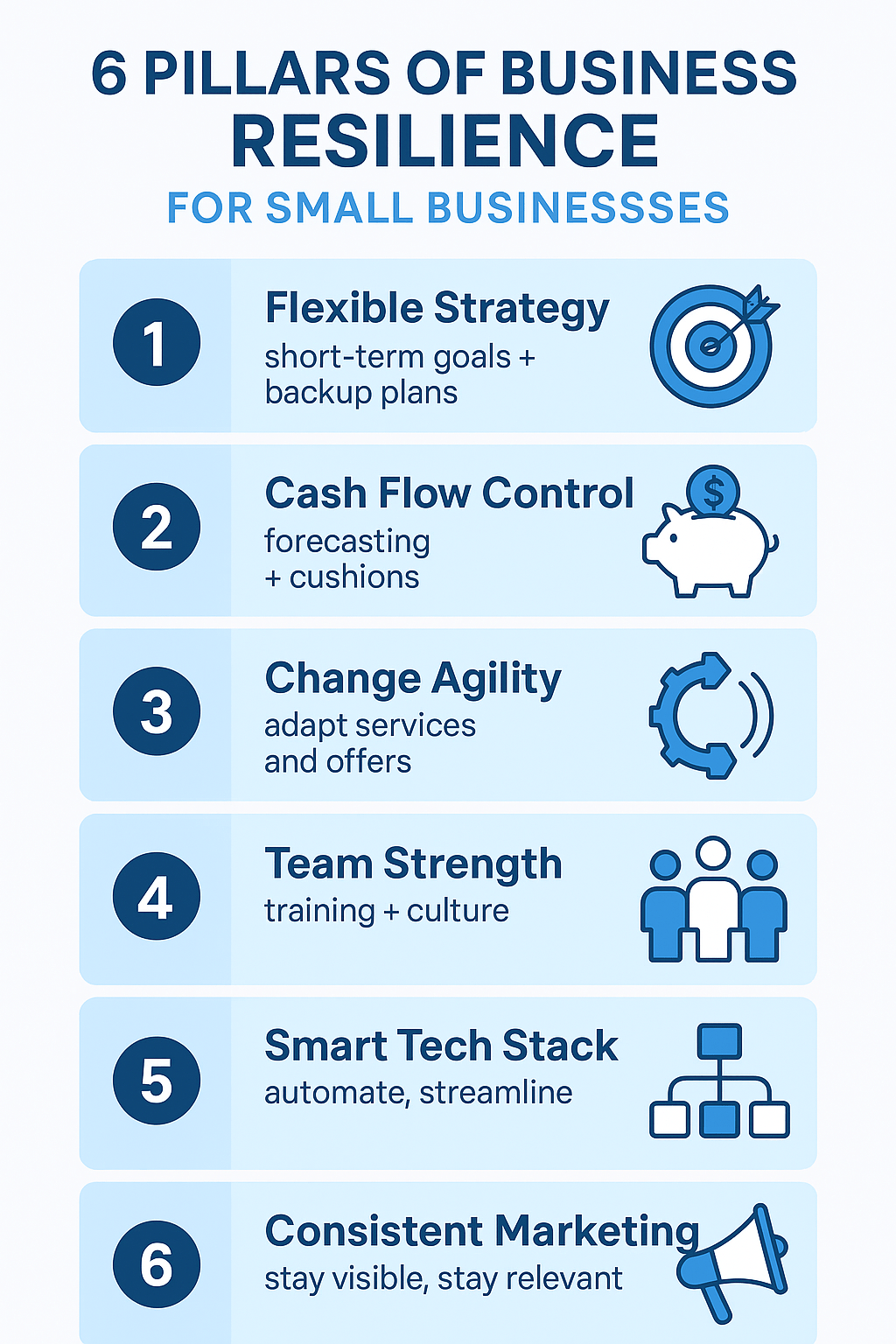How can a small business owner be successful? Running a small business is never easy. The hours are long, the margins are thin, and the odds aren’t exactly in your favor. According to the U.S. Bureau of Labor Statistics, about 50% of small businesses fail within the first five years, and only around one in three survives a whole decade. Still, millions of small business owners push forward—so what sets the successful ones apart? The answer comes down to one core idea: business resilience.
In this article, we’ll break down how small business owners can cultivate business resilience—the ability to adapt, recover, and thrive through disruption. We’ll look at hard stats, real-world success stories, and actionable strategies to help you not only stay afloat but grow in unpredictable times.
Business resilience is the ability of a small business to adapt, stay strong, and bounce back from challenges—be it financial stress, shifting markets, or operational setbacks. It’s not just survival; it’s thriving by staying agile, prepared, and forward‑thinking.
Table of Contents
- What Is Business Resilience?
- 1. Build a Strategy That Can Bend, Not Break
- 2. Master Your Finances (Even If You Hate Numbers)
- 3. Get Comfortable With Change
- 4. Build a Strong, Invested Team
- 5. Use Digital Tools to Work Smarter
- 6. Stay Visible and Valuable to Customers
- 6 Pillars of Business Resilience
- Business Resilience Real-World Examples
- Business Resilience Is the New Competitive Advantage
What Is Business Resilience?
Business resilience is your company’s capacity to withstand stress—economic downturns, supply chain issues, staffing problems—and come out stronger. It’s more than just surviving a bad quarter. It’s about building a company that’s flexible, prepared, and agile enough to respond to change without crumbling.
Resilient businesses don’t hope for the best. They plan for setbacks, adapt fast, and never stop improving their systems.
1. Build a Strategy That Can Bend, Not Break
Rigid business plans age fast. What you need is a framework that’s structured but flexible. Instead of a single five-year plan, adopt a Quarterly Business Strategy Framework—breaking your objectives into short-term, 90-day goals that you can adapt as conditions change. This approach lets you pivot quickly when unexpected challenges arise, while keeping your long-term vision intact.
Include in your quarterly strategy:
- A lean operating model that minimizes waste and maximizes agility
- Emergency cash reserves (at least 3–6 months of expenses)
- Clear SOPs (Standard Operating Procedures) for common challenges
- Measurable short-term goals that guide your team every quarter
Think of it as running your business in 90-day sprints. Every quarter, review your progress, adjust your tactics, and plan for the next sprint. Over time, these iterative cycles build resilience, keep your team aligned, and ensure you’re prepared for whatever comes next.
2. Master Your Finances (Even If You Hate Numbers)
One common reason small businesses fail? Cash flow mismanagement. According to data from the U.S. Chamber of Commerce, 82% of small business failures are due to poor cash flow management.
To avoid this:
- Track every dollar with tools like QuickBooks or Xero
- Forecast monthly, not annually
- Know your break-even point
- Build cash cushions, not just profit
Financial literacy is a cornerstone of business resilience. If you’re not good with numbers, hire or consult someone who is.
3. Get Comfortable With Change
Markets shift. Trends die. Customer behavior evolves. Resilient businesses see these changes not as threats, but as opportunities.
Case in point: During the pandemic, many local restaurants pivoted fast. They launched digital ordering, added delivery through apps, and expanded into retail sales (meal kits, branded sauces). Those that adapted quickly not only survived but often outperformed pre-COVID sales numbers.
If you’re too attached to how things “used to work,” you’ll be left behind. Build systems and a mindset that welcome change—not resist it.
4. Build a Strong, Invested Team
No small business owner wins alone. Behind every resilient company is a committed team.
Retention is key. According to Gallup, companies with engaged employees see 21% higher profitability and 59% less turnover. Training, feedback, and clarity around roles build trust and autonomy.
Be transparent with your team, give them room to grow, and reward initiative. When you invest in people, you strengthen your foundation.
5. Use Digital Tools to Work Smarter
If you’re still relying on spreadsheets and sticky notes to manage your business, it’s time to upgrade. Resilient companies run on systems.
Use tools like:
- Notion or Trello for task management
- Shopify or Squarespace for ecommerce
- Canva for marketing content
- Zapier to automate repetitive tasks
These tools help reduce human error, speed up workflows, and give you data to make better decisions. Business resilience thrives on streamlined operations.
6. Stay Visible and Valuable to Customers
Marketing doesn’t need to be expensive—but it must be consistent. Many small businesses fade simply because no one knows they exist.
Focus on:
- Social media presence (pick 1–2 platforms you can maintain)
- Google My Business optimization
- Email newsletters with value—not just sales
- Asking for and displaying reviews/testimonials
Resilient businesses know their audience and show up regularly—online and offline.
6 Pillars of Business Resilience

Business Resilience Real-World Examples
Here are 3 real-world case studies of small businesses that succeeded by building resilience. Each shows a different angle: pivoting under pressure, surviving financial stress, and leveraging digital tools.
1. A Detroit Auto Repair Shop That Went Mobile
Before:
A family-run auto repair shop in Detroit was hit hard during COVID lockdowns. Foot traffic vanished, and revenue dropped 70% in just two months.
Resilient Move:
Instead of closing, they invested in a van and launched mobile repairs—brake jobs, oil changes, diagnostics—right at customers’ homes. They also added online booking and payment via Square.
Result:
Within six months, revenue was back to 85% of pre-pandemic levels. Now, even post-COVID, the mobile service accounts for 40% of total income and attracts a younger, tech-savvy clientele.
Lesson:
Flexibility in service delivery can create new income streams—even during crises.
2. A Small Coffee Shop in Denver That Built a Brand
Before:
This independent café relied on downtown commuter traffic. When offices went remote, their daily footfall tanked.
Resilient Move:
The owner quickly pivoted to ecommerce—selling branded coffee beans, mugs, and subscriptions online. She started a weekly email newsletter with brewing tips, recipes, and discount codes.
Result:
Ecommerce grew to cover 60% of lost walk-in revenue. Within a year, the business expanded into wholesale partnerships with local grocers.
Lesson:
Brand + digital = reach beyond the shop. You’re not just selling a product—you’re building a loyal audience.
3. A Screen Printing Business in Atlanta That Repositioned
Before:
This shop printed shirts for schools and events. When lockdowns killed group activities, their order pipeline dried up.
Resilient Move:
Instead of shutting down, they shifted to printing custom merch for online creators, small brands, and local causes. They also offered low-minimum runs and helped clients set up Etsy or Shopify stores.
Result:
The new niche now makes up 70% of their business. They’ve become a go-to partner for creators launching merchandise.
Lesson:
Business resilience isn’t just about reacting—it’s about repositioning where your value meets demand.
Business Resilience Is the New Competitive Advantage
Small business success isn’t just about good ideas or great timing. It’s about being ready. Ready for problems, ready to pivot, ready to push through.
The market will test you. Customers will change. Tech will evolve. You’ll lose money, staff, or momentum at some point. But if you’ve built business resilience, you’ll recover faster—and smarter—every time.
You don’t have to be perfect. Just prepared.

Andrej Fedek is the creator and the one-person owner of two blogs: InterCool Studio and CareersMomentum. As an experienced marketer, he is driven by turning leads into customers with White Hat SEO techniques. Besides being a boss, he is a real team player with a great sense of equality.
